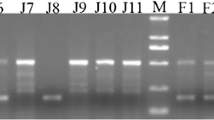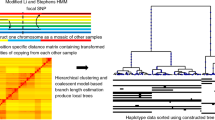Abstract
We have investigated the frequency distribution, across a broad range of geographically dispersed populations, of alleles of the polymorphicAlu insertion that occurs within the 8th intron of the tissue plasminogen activator gene (PLAT). ThisAlu is a member of a recently derived subfamily ofAlu elements that has been expanding during human evolution and continues to be transpositionally active. We used a “population tube” approach to screen 10 chromosomes from each of 19 human populations for presence or absence of thisAlu in the PLAT locus and found that all tested populations are dimorphic for presence/absence of this insertion. We show that the previously publishedEcoRI,HincII,PstI,TaqI, andXmnI polymorphisms at the PLAT locus all result from insertion of thisAlu and we use both restriction fragment length polymorphism and polymerase chain reaction analysis to examine the frequency ofAlu(+) andAlu(−) alleles in a sample of 1003 individuals from 27 human populations and in 38 nonhuman primates. Nonhuman primates are monomorphic for theAlu(−) allele. Human populations differ substantially in allele frequency, and in several populations both alleles are common. Our results date the insertion event prior to the spread and diversification of modern humans.
Similar content being viewed by others
References
Anderson MA, Gusella J (1984) Use of cyclosporin A in establishing Epstein-Barr virus-transformed human lymphoblastoid cell lines. In Vitro 20:856–858
Antonarakis SE, Chakravanti A, Halloran SL, Hudson RR, Feissee L, Karathanasis SK (1988) DNA polymorphism haplotypes of the human apolipoprotein APO Al-APOC3-APOA4 gene cluster. Hum Genet 80:265–273
Barr CL, Kidd KK (1993) Population frequencies of the Al allele at the dopamine D2 receptor locus. Biol Psychiatry 34:204–209
Batzer MA, Deininger PL (1991) A human-specific subfamily ofAlu sequences. Genomics 9:481–487
Batzer MA, Kilroy GE, Richard PE, Shaikh TH, Desselle TD, Hopeens CL, Deininger PL (1990) Structure and variability of recently inserted Alu family members. Nucleic Acids Res 18:6793–6798
Batzer MA, Gudi VA, Mena JC, Foltz DW, Herrera RJ, Deininger PL (1991) Amplification dynamics of human-specific (HS)Alu family members. Nucleic Acids Res. 19:3619–3623
Batzer MA, Stoneking M, Alegria-Hartman M, Bazan H, Kass DH, Shaikh TH, Novick GE, Ioannou PA, Scheer WD, Herrera RJ, Deininger P (1994) African origin of human-specific polymorphicAlu insertions. Proc Natl Acad Sci USA 91:12288–12292
Benham FJ, Spurr N, Povey S, Brinton BT, Goodfellow PN, Solomon E, Harris TJR (1984) Assignment of tissue-type plasminogen activator to chromosome 8 in man and identification of a common restriction length polymorphism within the gene. Mol Biol Med 2:251–259
Benham FJ, Spurr N, Povey S, Brinton BT, Solomon E, Goodfellow PN, Harris TJR (1985) Tissue-type plasminogen activator (PLAT) maps to chromosome 8 and there is a common restriction length polymorphism within the gene. Cytogenet Cell Genet 40:581
Bowcock AM, Bucci C, Hebert JM, Kidd JR, Kidd KK, Friedlander J, Cavalli-Sforza LL (1987) Study of 47 DNA markers in five populations from four continents. Gene Geogr 1:47–64
Bowcock AM, Kidd JR, Mountain JL, Hebert JM, Carotenuto L, Kidd KK, Cavalli-Sforza LL (1991) Drift, admixture, and selection in human evolution: a study with DNA polymorphisms. Proc Natl Acad Sci USA 88:839–843
Britten RJ, Baron WF, Strout DB, Davidson EH (1988) Sources and evolution of human Alu repeated sequences. Proc Natl Acad Sci USA 85:4770–1774
Deininger PL (1989) SINEs, short interspersed repeated DNA elements in higher eukaryotes. In: Howe M, Berg D (eds) Mobile DNA. Washington DC, ASM Press, pp 619–636
Deininger PL, Daniels GR (1986) The recent evolution of mammalian repetitive DNA elements. Trends Genet 2:76–80
Deininger PL, Slagel VK (1988) Recently amplifiedAlu family members share a common parentalAlu sequence. Mol Cell Bio 18:4566–4569
Deininger PL, Jolly DJ, Rubin CM, Friedmann T, Schmid CW (1981) Base sequence studies of 300 nucleotide renatured repeated human DNA clones. J Mol Biol 151:17–33
Donis-Keller H, Green P, Helms C, Cartinhour S, Weiffenbach B, Stephens K, Keith TP, Bowden DW, Smith DR, Lander ES et al. (1987) A genetic linkage map of the human genome. Cell 51:319–337
Economou-Pachnis A, Tsichlis PN (1985) Insertion of anAlu SINE in the human homologue of the Mlvi-2 locus. Nucleic Acids Res 13:8379–8387
Friezner Degen SJ, Rajput B, Reich E (1986) The human tissue plasminogen activator gene. J Biol Chem 261:6972–6985
Goldman D, Brown GL, Albaugh B, Robin R, Goodson S, Trunzo M, Akhtar L, Lucas-Derse L, Long J, Linnoila M, Dean M (1993) DRD2 dopamine receptor genotype, linkage disequilibrium, and alcoholism in American Indians and other populations. Alcohol Clin Exp Res 17:199–204
Hill A (1994) Late Miocene and early Pliocene hominoids from Africa. In: Corruccine RS, Ciochon RL (eds) Integrative paths to the past: paleoanthropological advances in honor of F. Clark Howell. Prentice Hall Press, Englewood Cliffs, NJ, pp 123–145
Jurka J, Smith T (1988) A fundamental division in theAlu family of repeated sequences. Proc Nall Acad Sci USA 85:4775–4778
Kidd JR, Black FL, Weiss KM, Balazs I, Kidd KK (1991) Studies of three Amerindian populations using nuclear DNA polymorphisms. Hum Biol 63:775–794
Knowler WC, Bennet PH, Hamman RF, Miller M (1978) Diabetes incidence and prevalence in Pima Indians: a 19-fold greater incidence than in Rochester, Minnesota. Am J Epidemiol 108:97–505
Leeflang EP, Liu W, Hashimoto C, Choudary PV, Schmid CW (1992) Phylogenetic evidence for multipleAlu source genes. J Mol Evol 35:7–16
Lichter JG, Barr CL, Kennedy JL, Van Tol HHM, Kidd KK, Livak KJ (1993) A hypervariable segment in the human dopamine receptor D4 (DRD4) gene. Hum Mol Genet 2:767–773
Lim D, Coleman RT, Assmann G, Frossard PM (1986) Deletion of anAlu sequence in the 5′ of the apolipoprotein AI gene associated with decreased serum HDL-cholesterol levels (abstract). Am J Hum Genet 39:621
Lu RB, Ko HC, Chang FM, Castiglione CM, Schoolfield G, Pakstis AJ, Kidd JR, Kidd KK (1995) No association between alcoholism and multiple polymorphisms at the dopamine D2 receptor gene (DRD2) in three distinct Taiwanese populations. Biol Psychiatry (in press)
Ludwig M, Wohn KD, Langer G, Schleuning WD, Olek K (1991) Detection of a Tagl polymorphism within the human TPA gene (PLAT). Nucleic Acids Res 19:4575
Matera GA, Hellmann U, Schmid CW (1990a) A transpositionally and transcriptionally competent Alu subfamily. Mol Cell Biol 10:5424–5432
Matera GA, Hellmann U, Hintz MF, Schmid CW (1990b) Recently transposedAlu repeats result from multiple source genes. Nucleic Acids Res 18:6019–6023
Orita M, Sekiya T, Hayashi K (1990) DNA sequence polymorphisms inAlu repeats. Genomics 8:271–278
Perna NT, Batzer MA, Deininger PL, Stoneking M (1992)Alu insertion polymorphism: a new type of marker for human population studies. Hum Biol 64:641–648
Quentin Y (1988) TheAlu family developed through successive waves of fixation closely connected with primate lineage history. J Mol Evol 27:194–202
Rogers J (1983) Retroposons defined. Nature 301:460
Ruano G, Kidd KK (1991) Coupled amplification and sequencing of genomic DNA. Proc Natl Acad Sci USA 88:2815–2819
Ruano G, Deinard AS, Tishkoff S, Kidd KK (1994) Detection of DNA sequence variation via deliberate heteroduplex formation from genomic DNAs amplified en masse in “population tubes.” PCR Methods Appl 3:225–231
Sambrook J, Fritsch EF, Maniatis T (1989) Molecular cloning: a laboratory manual, 2nd edn. Cold Spring Harbor Laboratory, Cold Spring Harbor, NY
Schmid CW, Shen CKJ (1985) The evolution of interspersed repetitive DNA sequences in mammals and other vertebrates. In: MacIntyre RJ (ed) Molecular evolutionary genetics. Plenum Press, New York, pp 323–358
Schmid CW, Deka N, Matera AG (1989) Repetitive human DNA: the shape of things to come. In: Adolph KW (ed) Chromosomes: eukaryotic, prokaryotic and viral, vol 1. CRC Press, Boca Raton, Fla, pp 3–29
Slagel V, Flemington E, Traina-Dorge V, Bradshaw H, Deininger PL (1987) Clustering and subfamily relationships of theAlu family in the human genome. Mol Biol Evol 4:19–29
Stringer CB, Andrews P (1988) Genetic and fossil evidence for the origin of modern humans. Science 239:1263–1268
Tishkoff SA, Dietzsch E, Speed W, Pakstis AJ, Cheung K, Kidd JR, Bonné-Tamir B, Santachiara-Benerecetti AS, Moral P, Watson E, Krings M, Pääbo S, Risch N, Jenkins T, Kidd KK (1996) Global patterns of linkage disequilibrium at the CD41ocus and modern human origins. Science 271:1380–1387
Ullu E, Murphy S, Melli M (1982) Human 7S RNA consists of a 140 nucleotide middle repetitive sequence inserted in anAlu sequence. Cell 29:195–202
Vidaud D, Vidaud M, Bahnak BR, Siguret V, Gispert Sanchez S, Laurian Y, Meyer D, Goossens M, Lavergne JM (1993) Haemophilia B due to a de novo insertion of a human-specificAlu subfamily member within the coding region of the factor IX gene. Eur J Hum Genet 1:30–36
Wallace MR, Andersen LB, Saulino AM, Gregory PE, Glover TW, Collins FS (1991) A de novoAlu insertion results in neurofibromatosis type 1. Nature 353:864–866
Weiner AM, Deininger PL, Efstratiadis A (1986) Nonviral retroposons: genes, pseudogenes, and transposable elements generated by the reverse flow of genetic information. Annu Rev Biochem 55:631–661
Willard C, Nguyen HT, Schmid CW (1987) Existence of at least three distinctAlu subfamilies. J Mot Evol 26:180–186
Wilson AC, Sarich VM (1969) A molecular time scale for human evolution. Proc Natl Acad Sci USA 63:1088–1093
Wohn KD, Ludwig M, Langer G, Olek K, Schleuning WD (1990) XmnI polymorphism in the human TPA gene. Nucleic Acids Res 18:5326
Yang-Fang TL, Opdenakker G, Volckaert G, Francke U (1986) Human tissue-type plasminogen activator gene located near chromosomal breakpoint in myeloproliferative disorder. Am J Hum Genet 39:79–87
Author information
Authors and Affiliations
Rights and permissions
About this article
Cite this article
Tishkoff, S.A., Ruano, G., Kidd, J.R. et al. Distribution and frequency of a polymorphicAlu insertion at the plasminogen activator locus in humans. Hum Genet 97, 759–764 (1996). https://doi.org/10.1007/BF02346186
Received:
Revised:
Issue Date:
DOI: https://doi.org/10.1007/BF02346186




